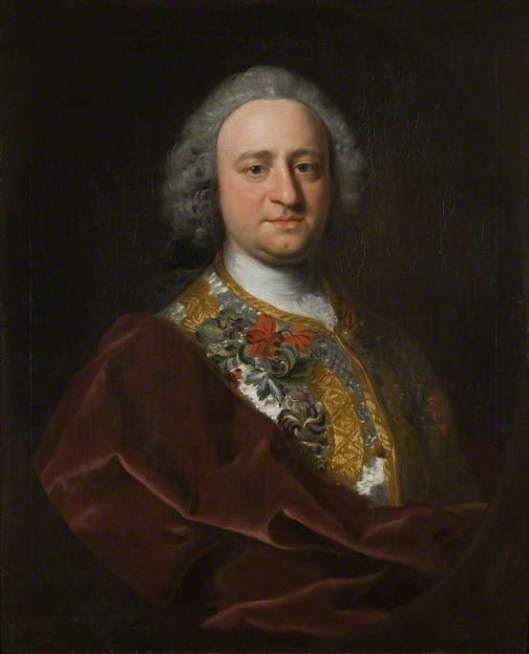Earlier this month I wrote about two sons of my 7th great grandparents Thomas Champion de Crespigny and Magdelaine Granger. William was apprenticed to an Inner Temple lawyer, and Philip, my 6th great grandfather, was apprenticed to a proctor of Doctor’s Commons.
The youngest surviving child of Thomas and Magdelaine was Claude (1706 – 1782). In 1721, the same year his brother William died, Claude became a junior clerk in the South Sea Company. His mother probably could not afford to apprentice him to a lawyer like his brothers.
The South Sea Company had been established ten years previously. It was formally constituted as an enterprise to trade with South America and islands of the ‘South Seas’ – hence the name – but it in practice it quickly became an institution dealing in government finances, particularly the national debt. It was arranged that holders of official debt could be reimbursed with shares in the Company. The government paid annual interest and a fee, and the money was available for distribution as a dividend to shareholders. As payment of moneys owing to Thomas by the Government at the time of his death, Magdelaine Champion Crespigny received shares in the South Sea Company when her husband Thomas died.
The arrangement was in competition with the Bank of England. It was ingenious but it was open to corruption, and the celebrated “South Sea Bubble” of 1720 caused widespread financial ruin and brought down the government.

“Emblematical Print on the South Sea Scheme“, an early print by William Hogarth, created in 1721. It caricatures the financial speculation, corruption and credulity that caused the South Sea Bubble in England in 1720–21. Retrieved from Wikimedia Commons.
A parliamentary inquiry was held to determine why the bubble had burst. In the wake of this investigation, a number of politicians were disgraced, and people who were found to have profited immorally from the company had their personal assets confiscated in proportion to their gains (most had already been rich and remained so). Despite this, the Company was restructured and continued to operate.
Although most histories emphasise the Bubble and the Company’s position at the centre of the disaster, the South Sea Company continued to function for another 130 years, issuing shares to raise money, lending that money to the government, and using the interest received on the loan to pay dividends on the shares. No longer a source of reckless excitement among investors, it was a substantial organisation whose stock provided steady dividends. It was traded at a rate comparable to the East India Company and the Bank of England.
Claude Champion de Crespigny joined the company immediately after the 1720 collapse. He worked his way through the ranks, and ten years after joining, Claude, 25 years old, was appointed First Clerk in the office of the Secretary. reported in The Gentleman’s Magazine of April 1731. He was 25 years old.
In May 1745 an employee of the Company named Thomas Shuttleworth embezzled the very considerable sum of twenty thousand pounds and fled to Amsterdam. He was thought to be headed for Italy, and the directors offered two hundred pounds to anyone who captured him. They also sent Claude Crespigny, and it was reported in July that he had recovered a banker’s draft for ten thousand pounds originally intended for Mr Shuttleworth.

Claude Crespigny (1706–1782) by Jean-Baptiste van Loo (1684–1745) (attributed to) In the collection of Kelmarsh Hall and retrieved through artuk.org

Bookplate of Claude Crespigny of the South Sea House together with an inscription and his signature. It is interesting that Claude Crespigny identified himself as of the South Sea House by 1745 when he was still a clerk. The book and its bookplate is now in the Princeton University Library.
In October 1753 The Gentleman’s Magazine reported that Claude Crespigny Esquire had been appointed Secretary of the South Sea Company, replacing the former Secretary, who had died in office. He was Secretary – Chief Executive Officer – of this major financial institution for almost thirty years before dying in office himself.

Death notice for Claude Crespigny in The Gentleman’s Magazine vol 52, 1782, page 503. Claude Crespigny died at Champion Lodge, Camberwell, then the house of his nephew Claude deC (1734 – 1818), formerly the house of his brother Philip who had died in 1765.

“The South-Sea House in Bishops-gate Street“, engraving by Thomas Bowles, published 1754. (In 1754 Claude Crespigny was Secretary of the South Sea Company.) Retrieved from Wikimedia Commons.
The headquarters of the South Sea Company was Old South Sea House, on the corner of Bishopsgate Street and Threadneedle Street in the City of London. The building burned down in 1826.

The location of the Old South Sea House on the corner of Bishopsgate and Threadneedle Streets is marked with a black x
Sources
- de Crespigny, Rafe Champions from Normandy : an essay on the early history of the Champion de Crespigny family 1350-1800 AD. Lilli Pilli, New South Wales Richard Rafe Champion de Crespigny, 2017. Pages 140-7. Can be viewed at Champions from Normandy
Related posts
- C is for Camberwell: house where Claude died, the home of his brother Philip and nephew Claude
- I is for Inns of Court: includes Claude’s brother William
- K is for Knightrider Street: Claude’s brother Philip


